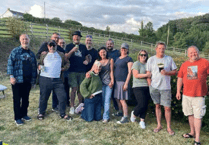Cornwall Wildlife Trust is on a mission to restore local intertidal seagrass meadows in Cornwall and are appealing for help.
Cornish walkers are being asked to keep an eye out when walking at low tide, getting to know seagrass better and helping to build a clearer picture of its condition and history. Intertidal seagrass, a flowering plant, can look just like grass growing on the shore.
It thrives in sheltered, muddy areas and is fantastic at storing carbon, as well as creating habitat for a wide variety of species. Over the past 50 years, 92 per cent of national seagrass beds have been lost, with the biggest declines seen in intertidal seagrass beds in our estuaries.
The trust is determined to restore these local intertidal seagrass meadows. Research has shown that muddy estuarine seagrass beds hold up to four times more carbon than those found in deeper waters.
With support and funding from Seasalt Cornwall over the past three years, the trust has trialled several different methods of replanting intertidal seagrass on the Fal-Ruan and Helford estuaries.
Thanks to this work, there is now a robust methodology ready to be rolled out across Cornwall. This is where the public come in - new areas need to be identified for restoration.
Cornwall Wildlife Trust’s seagrass project assistant, Beth Ford said: “We want to give nature a helping hand by restoring sites in Cornwall where intertidal seagrass was once present but has now disappeared.”
Finding these new restoration sites is challenging, as historical records of their locations are very limited.
The trust’s seagrass project officer, Chloe James said: “Memories from local residents can help build a picture that will aid our active restoration and support recovery.”
To provide any information that might be useful to the project, contact Cornwall Wildlife Trust on 07966 581046 or email [email protected]




